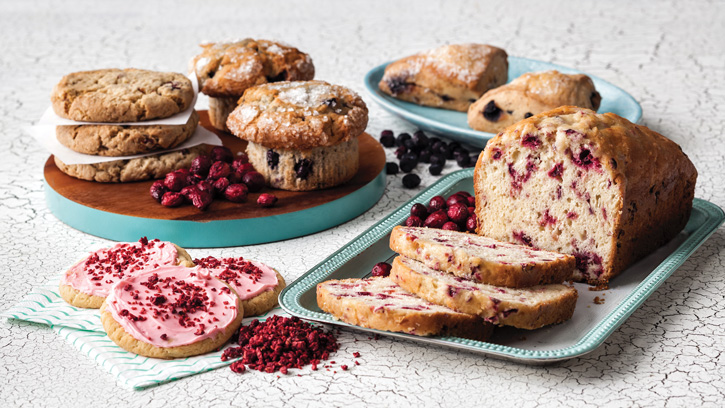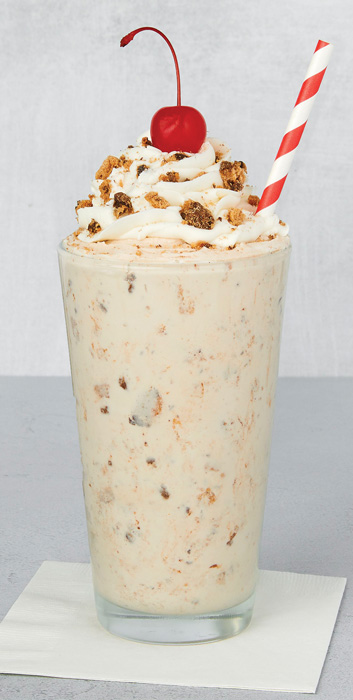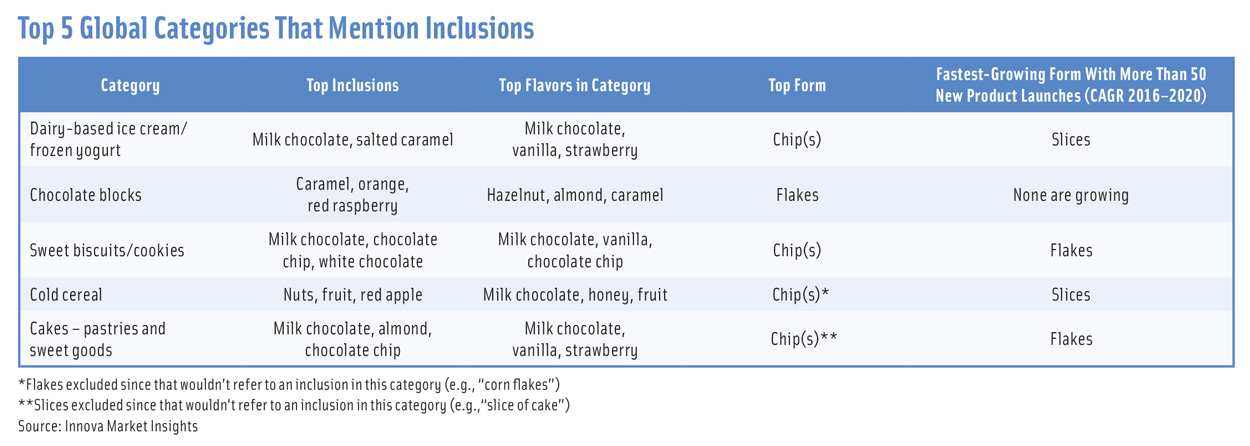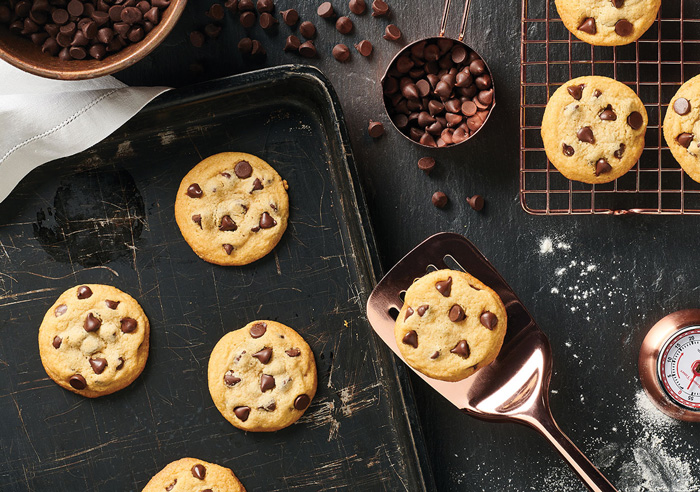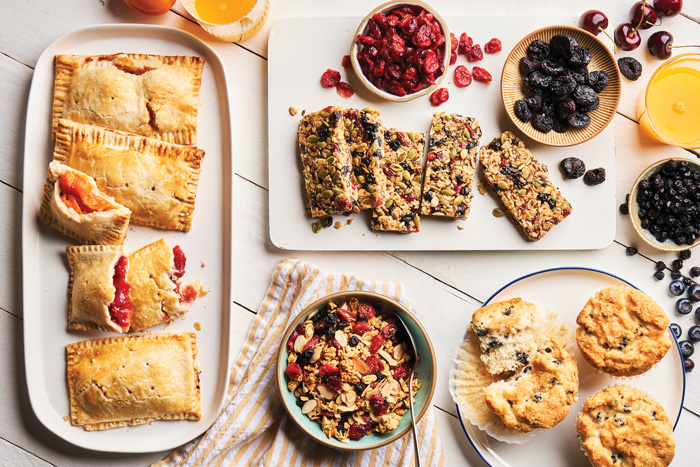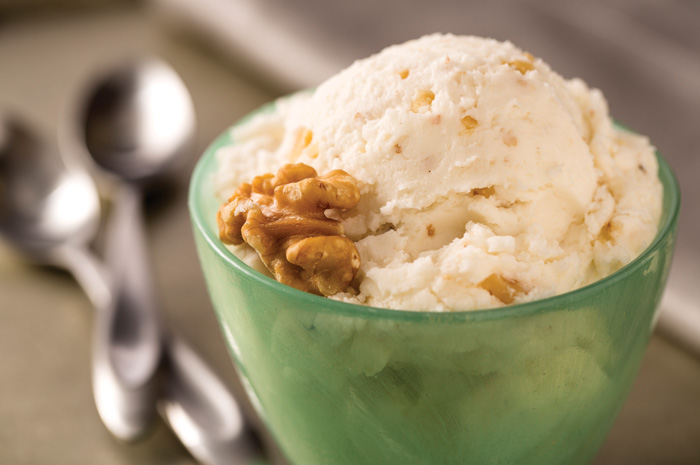Small Additions for Maximum Impact
INGREDIENTS
To see the kind of power that creative inclusions can wield, look no further than Marble Slab Creamery’s Cheetos Flamin’ Hot Ice Cream. Available for a limited time in late summer and early fall, the marriage of sweet cream ice cream and crushed Flamin’ Hot Cheetos from Frito-Lay/PepsiCo garnered loads of media attention in our Instagram-happy world.
Not every inclusion needs to be quite so dramatic to be successful, of course. But inclusions provide a prime opportunity to help food and beverage products stand out from their competition, satisfy consumers’ growing appetite for permissible indulgence, and tap into texture trends. In fact, the elevation of texture as a key product attribute, along with taste and aroma, is a growing trend in inclusions, says Jennifer Williams, marketing director, branding and food innovation at California Walnut Board.
Consumers consistently rate flavor and texture as top reasons for dessert trial, for example, says John Pimpo, marketing director at Parker Products. “Great texture drivers can be found through familiar items like cookie crumbs, streusels, praline nuts, and granolas or unique items like cookie gems, baked brownie pieces, or cookie doughs,” he says.
The global market for food inclusions is projected to increase at a compound annual growth rate of 7.4% from 2020 to 2028, according to ResearchAndMarkets.com. The predicted jump from about $12.5 billion in 2020 to nearly $22.4 billion in 2028 is being driven in part by the availability of a variety of food products to satisfy consumers’ palates, according to the research firm.
The new flavors and forms of inclusions adding oomph to food products range from the sublime to the (almost) ridiculous. In July, Mondelēz International stirred new Chunky CHIPS AHOY! Cookie Pieces into its mix of on-trend inclusions for use in frozen desserts, baked goods, and sweet treats. New Candy Pop Popcorn with Sour Patch Kids, rolled out this summer, pairs popcorn with Redberry drizzle, Sour Patch Kids candy bits, and sour sugar sprinkles.
On the sweet, savory, and umami side, Jeni’s Splendid Ice Cream earlier this year spread chunks of buttery streusel containing sesame, poppy seeds, onions, and garlic throughout a sweet cream cheese base to create its new Everything Bagel flavor. Topping it off, Big G Instant Oatmeals from General Mills began bowling over consumers in June with branded DIY toppings including marshmallows for Lucky Charms vanilla-flavored oatmeal, cinnadust for Cinnamon Toast Crunch cinnamon oatmeal, Trix colorful crunch topping for Trix fruit-flavored oatmeal, and chocolate-flavored crunchy topping for Cocoa Puffs chocolate-flavored oatmeal.
Inclusions provide flavor, texture, and color advantages that can elevate even the most ordinary food product to new heights of consumer appeal. Let’s take a look at the latest trends in the top segments for inclusions: chocolate, fruits, and nuts.
Chocolate Choices
Chocolate is the granddaddy of the inclusions market, accounting for the largest revenue share in the global food inclusions market in 2020, according to ResearchAndMarkets.com. Among inclusions flavor segments, the chocolate and caramel segment also made up a major share of revenue in 2020.
Chocolate inclusions can offer formulators the capability to cater to consumer desires for both indulgence and healthy eating at the same time, says Gretchen Hadden, marketing manager at Cargill Cocoa & Chocolate.
“Chocolate will forever remain a much-sought ingredient for [snack and bakery] applications. However, slight nuances can provide consumers with permission to treat themselves [and balance indulgence and better-for-you],” says Hadden. “For example, high cacao chocolate chips—which some consumers perceive as having a health halo—are inherently lower in sugar than milk or white chocolate chips.”
Chocolate inclusions that can fit well into better-for-you categories such as healthier snacks, energy bars, and cereals include cleaner label offerings, sustainable chocolate, and value-added solutions such as sugar-free, no sugar added, organic, plant-based, and even protein-enriched inclusions, says Laura Bergan, director of Barry Callebaut Brand.
“An emerging area for chocolate inclusions that is growing with continued momentum is plant-based inclusions,” says Bergan. “We believe consumers will continue to desire decadent and delicious sweet treats but will demand more holistic health benefits in parallel. Plant-based solutions fit squarely in this consumer demand space.”
Hadden also sees plant-based chocolate compound inclusions as an area of potential growth in the next few years, as the number of consumers identifying as flexitarians rises. “Not only will these inclusions play a role in snacking, but we also see a place for them in categories such as bakery, where consumers often look to rationalize their indulgences,” she says.
Premium chocolate inclusions, including decadent flavors with multisensorial aspects such as filled cups and chips, are also on the rise, adds Bergan. “We have seen more premium products such as Belgian chocolate and Swiss chocolate inclusions, and . . . we see higher cacao percentage of chocolate offerings,” she says. “Our newest innovation, our Magical and Monster morsels, uses our swirling technology to bring forward dual colors in baked goods and snacks, which consumers are demanding at retail shelves.”
Hadden adds that bakery and snack applications are ripe for more elevated, premium chocolate inclusions. “The bean to bar chocolate trend has increased consumers’ appreciation for chocolate with a story,” she says. “Whether that’s in the form of origin denotation of the cocoa bean or greater visibility into how the cocoa beans were sustainably produced, there is opportunity for food manufacturers beyond confectionery to adopt these premium chocolate cues that consumers have demonstrated interest in.”
At the opposite end of the spectrum, chocolate’s comforting qualities make it a perfect inclusion for down-home comfort foods, says Hadden. “Consumers’ quest for packaged treats that rival ‘home-baked’ continues,” she says. “Whether that’s doubling down on inclusions for extra indulgence or using irregular-shaped chocolate chunks for that ‘perfectly imperfect’ look, there are a variety of choices that can help snack manufacturers inch closer to the at-home cookie jar.”
Working with chocolate inclusions can present challenges, such as keeping the chocolate suspended in batter to mitigate it from sinking to the bottom, says Lauren Kumpf, associate food technologist at Cargill Cocoa & Chocolate. “One way to minimize this is by tossing the chocolate inclusion with some flour or a dry mix such as cake mix or brownie mix.”
Another challenge, says Kumpf, is the potential for burning the chocolate, especially when chocolate inclusions are placed on top of baked goods.
“It’s best to add the inclusion on top toward the end of the bake cycle, limiting the amount of time the exposed chocolate is in the heat of the oven,” she explains. “This isn’t a concern with chocolate pieces that have been mixed in with a dough or batter, as the dough or batter helps to slowly raise the temperature of the chocolate’s environment and still keep it cooler than what the oven is set at.”
Fruitful Additions
The fruit and nuts segment is expected to register the highest growth rate in terms of revenue among all inclusions from 2020 to 2028, reports ResearchAnd-Markets.com, while the fruit segment is projected to have the highest revenue growth rate among inclusions flavors during the same period.
“Consumer trends like better-for-you, immune and gut health, and sustainability are having a profound influence on fruit and vegetable inclusions,” says Jennifer Triem, Western U.S. sales manager at Chaucer Foods, citing data from Innova Market Insights that found 60% of global consumers are increasingly looking for food and beverage products that support their immune health. “Incorporating ingredients such as freeze-dried fruits and vegetables within a variety of product applications can boost nutritional claims that attract health-conscious consumers.”
“Baby boomers want foods that strengthen immunity and are high in antioxidants,” adds Dave Schanzer, CEO of Traina Foods. “Blueberries, cherries, strawberries, cranberries, and plums all fit that bill.”
As consumer familiarity with the U.S. Department of Agriculture’s (USDA) Dietary Guidelines for Americans continues to grow—46% now say they know a lot or a fair amount about the guidelines, compared with 41% in 2020, according to the International Food Information Council’s 2020 Food and Health Survey—inclusions can make it easier for consumers to ensure they’re getting enough servings of fruits and vegetables every day.
“Many consumers are starved for time and are looking for easy, more convenient ways to bring healthy eating into their routine,” says Gary Augustine, director of marketing at Van Drunen Farms. “[That’s why] fruit and vegetable inclusions are popular in the snack, bakery, beverage, and prepared food categories.”
Van Drunen’s TruServ label claim verification program for its whole food fruit, vegetable, and greens powders and pieces, for example, provides a way to communicate USDA-equivalent whole food fruit and vegetable servings on the finished packaging label. “Each claim has been TruServ Verified by Van Drunen Farms’ exclusive method of substantiation that connects our extensive production data and the USDA nutritional database to only our fruit, vegetable, and leafy green ingredients,” says Augustine.
Dried or frozen ingredient inclusions also offer advantages for product developers facing organoleptic challenges that are common when working with fruit and vegetable inclusions, says Augustine. “For example, these ingredients deliver piece identity, consistent taste and texture, flavor variety, and longevity,” he says.
“Formulating with MicroDried fruits and vegetables results in an end product with great piece identity since the cell structure stays intact even through mixing, blending, and retort processes,” says Heidi Farkas, national sales and marketing manager at Milne MicroDried.
Other challenges for fruit and vegetable inclusions include working around the moisture content of the ingredients incorporated into the food or beverage product, says Triem.
“Unlike other drying methods, freeze-drying allows fruits and vegetables to retain their flavor and color as well as any nutritional value,” she says. “They are also 100% natural and contain no added sugar—attributes that are increasingly important to today’s clean label and health-focused consumer.”
Freeze-dried fruits are versatile ingredients for products such as chocolate bars, ice cream, kombucha, salads, meal replacement cookies and protein bars, and snack mixes, says Triem. “Freeze-dried fruit pieces and powders quickly infuse in hot or cold liquid and are ideal for adding natural color and flavor to teas, cocktails, soft drinks, and sparkling waters,” she says.
Triem adds that freeze-dried fruit inclusions are a natural option for better-for-you categories like vegan and keto products, such as incorporating freeze-dried strawberries or raspberries in vegan ice cream for a sweet taste.
“Freeze-dried fruits are becoming more popular in keto-based food products,” she says. “Keto brands of ice cream and candy bars have been looking to add freeze-dried fruits to their products to provide sweetness with low sugar content and a clean label.”
Inclusions in a Nutshell
The rising demand for nuts to enhance flavor and boost nutrition helped give solid and semisolid inclusions the major revenue share among inclusions formats in 2020, according to ResearchAnd-Markets.com. “The pandemic has reinforced consumer interest in health and well-being, and driven at-home consumption of nuts, seeds, and trail mix,” said Mimi Bonnett, director–U.S. food and drink at Mintel, on the company website. “However, growing the market and appealing to younger generations in particular will require innovation in flavors and functionality.”
General Mills, for instance, is highlighting the nutrient density of nuts and seeds in its new Good Measure brand, launched in late June online and at Hy-Vee stores in Minnesota. The creamy nut butter bars and crunchy almond crisps are designed to have little impact on blood sugar, according to the company. Hostess Brands, on the other hand, is promoting its new Hostess Pecan Spin, a sweet cinnamon roll topped with chopped pecans, as an indulgent, texture-rich snack for consumers on the go.
The versatility of walnuts in particular has made them a favorite with food companies looking to appeal to a wide variety of consumer demographics, says California Walnut Board’s Williams.
“We’re seeing a growing interest for walnut inclusions in everything from muffins to salads to ice cream, mainly due to walnuts’ ability to deliver an inclusion that provides great taste, texture, and nutritious properties,” she says. “Although walnuts are not a new inclusion, we are seeing manufacturers use them in new ways, specifically as a functional inclusion. Walnuts are the only nut that provides a significant amount of plant-based omega-3 alpha-linolenic acid, with 2.5 g per ounce.”


